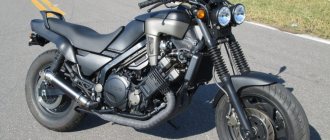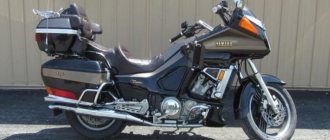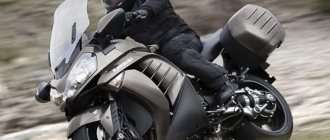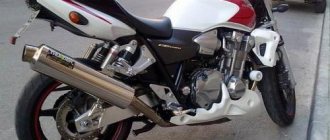Bike features
Here are the main features of the Yamaha XT 250 Serow:
- off-road efficiency;
- well-tuned suspensions;
- achieving both maximum torque and maximum power at 6500 rpm.
The last point deserves special attention. Due to the fact that the number of revolutions per minute for maximum power and torque is the same, the motorcycle can maintain its dynamics until the last moment. This makes the Yamaha XT 250 Serow one of the best dirt bikes, certainly among the small capacity options.
Dimensions and weight
Depending on when a particular model was released, dry weight varies. In general it ranges from 110 kg to 120 kg. Together with fuel, the car will weigh a little more - approximately 130 kg. The tank volume here is 9.8 liters, which is excellent for such a vehicle. Average fuel consumption per hundred km is about 3 liters. The seat height of the XT 250 Serow is 810 mm, its length is 2150 mm, its overall height is 1160 mm, and its width is 805 mm.
Features and Features
Yamaha, together with the Italian company Pininfarina, did a lot of work on the appearance of the motorcycle. The design is so successful and attractive that it has remained unchanged for 15 years and does not lag behind its modern competitors.
The motorcycle was based on the frame from the Yamaha Tricker, which debuted a year earlier, in 2004. Due to the good layout of the main components, the Yamaha Serov 250 is very easy to operate. It can be used to perform complex motorcycle maneuvers such as riding and wheelie turns.
The engine was transferred from the previous model Serov 225. The cylinder volume was increased to 249 cc. The transmission was simplified from a 6 to a 5-speed gearbox. The first gear has become a little longer than on the Serov 225. In first gear you can go faster.
The engine turned out to be high-torque throughout the entire speed range. Pulls well at any speed. This allows you to use the motorcycle in mountain conditions. In first gear, the bike starts off easily on steep climbs. Effective when driving off-road.
A simple two-valve air-cooled engine, so it is normally noisy and gives the impression of a motorcycle with a larger engine capacity.
Economical fuel consumption is 2.5 - 3 liters per 100 km.
The short-travel suspension remains unchanged.
The saddle height is low - 81cm. Due to this, at low speeds you can avoid falling, since your legs can freely reach the ground.
The bike is ideal for beginners, teenagers and girls.
The motorcycle is easy to control and corners well. Gear shifts quickly and clearly. The Yamaha Serov 250 engine has a long service life: the engine is reliable, rarely breaks down, spare parts are available.
As you can see, there are basically only advantages.
There are few disadvantages:
- slow acceleration
- max speed only 120 km/h
Chassis and brakes
The frame of this machine is made of steel. It looks sophisticated thanks to the efforts and taste of the designers. Probably, this bike can be called, without any exaggeration, one of the most beautiful lightweight enduros. Everything in it is verified, from the steering wheel typical for the class to the neat spoked wheels. Thanks to all the design delights, the XT 250 Serow looks not just modern, but futuristic.
At the rear of this model, the suspension role is played by a pendulum version with a monoshock absorber. At the front there is a telescopic fork with dimensions of 35 mm. The rear brake for the motorcycle is a disc with a diameter of 203 mm together with a single-piston caliper. At the front, the bike brakes thanks to a 245 mm disc along with a two-piston caliper.
Review of the Yamaha Serow 250 (XT 250) motorcycle
I recently bought a Serov 2001. It’s my first motorcycle, so I have nothing to compare it with except mopeds, which I last rode as a child about 10 years ago. But, having ridden it, I couldn’t agree with this (in any case, for the first motorcycle there are definitely quite a few of them, unless you weigh 100 kg, of course). This is the second motorcycle I’ve ridden in my life (the first was a Jebel 200, on which I opened Cat. A in driving school).
They say that it is not for hard off-roading and does not like jumping (the chassis gets loose quickly). Others have been jumping for more than one season and everything is fine. I rode on a dirt road with medium-sized potholes at quite a low speed (about 60-70 km) - the fork never pierced. On the primer the full potential of the engine was not revealed. It's enough on the asphalt, but sometimes you want more. Although, for a beginner this is unnecessary. Besides, driving on asphalt is boring, so it’s not critical.
In general, for the first moto, I think it’s a worthy choice. And also for those who don’t need to fly headlong between the trees, although you can also catch a drive on a serov. But with experience this may not be enough, although the 250 is also not a gun, then you’ll probably want a 400. that very quickly, using their potential, but people have many years of training behind them.
In general, I wanted an enduro for off-road driving. But on XP I could only reach the ground with my toes (my height is 169), so I was looking for something lower... The choice fell on:
1. Honda Digri
The option is not bad, 250 cubic meters, 25-26 horses.. The chassis is about the same as the Serov. Motorcycle for mountains with a low seat back. What put me off was that it was not popular and, apparently, was produced before 1996; in any case, I didn’t find anything more recent. There were only two options, both with mileage in the Russian Federation and not attractive appearance. And this is all provided that the price is the same as for b/p serov. It also has water cooling. On the one hand this is a plus, on the other hand there is a higher complexity of the design. Possibility of damaging the radiator in the forest (especially for a newbie due to inexperience). And service is more difficult.
2. Suzuki Jebel 200cc
I read the testing of it and Serov. Jebel leaked. In general, at first I learned a lot about the jebel, it’s a good motak. But 250ka is not low in terms of landing. I thought that the only difference was in the engine (200 and 250). But it turned out that these are completely different motorcycles. And the 200 is quite weak, besides, there are only 5 speeds (there are 6 on the Serov). In general, Jebel 200 is no longer needed. In principle, the 250 is lower in fit than the XP, but I still wanted more confidence in the saddle, and the price is on average 30 thousand more than the Serov, if you take a used one in the Russian Federation and a recent year.
3. Yamaha Serov
Well, everything is clear here. I wrote a lot about him above. By the way, when I asked a seller in the “moto world” what first enduro to take for the forest at my height, he answered without hesitation: Serov.
4. Kawasaki SuperSherpa
Seemed to be the closest competitor to Serov! Very similar in many respects. But it is less popular and there is very little information on the Internet. I found only one test in which they responded negatively to kava. Same price. It's difficult to compare them. I've never even seen him live. The only thing that put me off was the lack of information and one negative review on the internet. There are a lot of videos about the Sers on YouTube. Digri and Sherpa barely appear there.
5. Honda XP 230
There was only one option and it was sold. And the price is 20 thousand higher for one that has been running around the Russian Federation, however, it started in 2005 and it was this year that it was sold on the internet. It looks like a complete copy of the XP250, only with a low stance. But as it turned out later, the “insides” are completely different. So, it is unlikely that he is very different from Serov. Rather, it is one of the mountain analogues. Perhaps it replaced the digri, only with air cooling.
6. Yamaha TTR 230
I actually found out about him quite by accident on one of the forums. There is no information, but it is there))
To summarize, we can distinguish 3 models: Digri, Serov and Super Sherpa. I won’t say anything about the latter, but somehow it did not inspire confidence. Therefore, I would look more towards Digri and Serov. By the way, the Serov has only two valves, which makes its engine even simpler. I was pleased with my choice, although the Honda XP 250 still haunts me!)) But the price is slightly different, and it’s not suitable for my height (considering that this is my first motorcycle). In the future, when I gain experience, perhaps I’ll take this one, or better yet, the Honda XP 400 ...
The first thing that catches your eye is how light it is. It steers like a bicycle, the ease of control is simply beyond words. The engine is sharp, even very peppy, enough from the bottom, it can easily pull 5-10 km/h at low idle speeds and in second gear uphill at 50-60 degrees (we have a lot of these in Vladivostok :).
It gets onto the wheel from the gas, although only in 1st gear and you have to try hard. But with all this, the gas is supplied softly and feels soft, that is, it will not be possible to accidentally over-gas, and even more so it will not provoke waste. Once upon a time, somewhere, I read very correctly about the Sherpa - “It’s on the Yamaha VR that you want to PUSH, FLY FOR A FIFTY KONE IN THE SHIT ON THE REAR WHEEL, but on the Sherpa you ride calmly, squirrels, flowers, nature... beauty.”
This applies to Serov in the same way - this is still not a sports device, and you don’t want to push it too hard, although it can be crazy if necessary. But it’s good at what it was designed for – climbing. For example, along power lines, in mountains, or anything else with a slope of at least fifty dollars in degrees. The first VERY short tractor gear (up to 25 km/h, if my memory serves me correctly) and the height (inexperienced riders can help themselves with their feet) decide; to say that it’s convenient is to say nothing. And he really drags himself calmly, puffs like a donkey, and drags him up the hill...beauty. Speaking of gears - they are really very short, and in the city those who do not like to click them will feel a strong burning sensation just below the lower back - they will have to switch constantly. A clear example is that you can safely and comfortably shift into 5th (the last bitch!) gear already at 50 mph, but according to the manual it is recommended to switch to it at 40 mph, but where is that good? However, on the highway, such a gear ratio will make everyone feel hot, because the comfortable cruising speed on it ends already at 80 km/h, 90 is the edge, then the engine begins to howl indecently, hinting “well, stop raping me, please!” But driving a long distance with constant engine speeds around 6-7k... is not much of a pleasure, and it’s not all that pleasant for the motorcycle. At the same time, there is no noticeable lack of power, the car generally picks up a hundred very quickly (just for fun, I recently went with a turbo Skyline 260+hp, we went head to head until about a hundred), after a hundred-110 it really doesn’t pick up so quickly, but at 120 it deflates completely and further accelerates extremely reluctantly. However, such gears are perhaps the only negative that I could find in this spendthrift. In terms of operation, it’s a Yamaha, that says it all. The engine is a modified version of the 225, simple and indestructible like a Kalashnikov assault rifle, but at the same time very noisy and likes to eat up oil if it is pounded for a long time at high speeds.
It consumes a little, about 3l/100km, on the highways if you fly and hum at rpm – 4.5. The headlight shines very well despite its size, driving at night is comfortable.
The instrumentation is very cool, I always liked digital speedometers, the tripmeter also comes in handy sometimes.
Oh, and yes - emergency lights are present, a useful thing in the aisle or thank someone there to say






